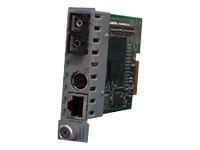This website stores cookies on your computer. These cookies are used to collect information about how you interact with our website and allow us to remember you. We use this information in order to improve and customize your browsing experience and for analytics and metrics about our visitors both on this website and other media. To find out more about the cookies we use,
see our Privacy Policy.
-
Temporarily Out-of-Stock
- Call for next available delivery
Add to Cart
Messages
 Loading
Loading
-
:
Quick View
 Getting Details
Getting Details
- Ethernet 100Base-FXEthernet 100Base-TXEthernet 10Base-T Transceiver
- 100.0Mbps100Mbps Transfer Rate
- Ethernet, Fast Ethernet Protocol(s)
- FCC Class B certified, UL Compliant
The iConverter 10/100M2 conforms to the Ethernet in the First Mile (EFM) fiber standards to support Fiber-to-the-X Metropolitan and Enterprise LAN networks. The 10/100M2 provides intelligent, securely managed service demarcation at the customer premises, offering Layer 2 Control Protocol (L2CP) policy control, Quality of Service and enhanced bandwidth control (rate-limiting) capabilities. The 10/100M2 features built-in Operations, Administration and Maintenance (OAM) with comprehensive performance monitoring, fault detection and provisioning.
8903N-1 supports port access, enhanced bandwidth control, port MIB statistics and 2,048 byte frames.
The 10/100M2 features multiple, user-selectable link fault detection modes for quick fault detection and isolation. These modes operate independently of the network management and monitor the state of the cabling hardware.
Link-Segmentation (LS) is the normal (default) mode where the UTP and fiber ports establish their links to other connected devices independently of each other.
In Link-Propagation (LP) mode (also known as Link-Loss-Carry-Forward), a link-out from the UTP port is generated only when a link-in to the fiber port is present, and a link-out from the fiber port is generated only when a link-in to the UTP port is present. In LP mode, a cable or link fault is propagated in a domino fashion to downstream or upstream connected equipment, enabling rapid fault detection.
Asymmetrical Link Propagation (ALP) has two modes of operation: copper-to-fiber and fiber-to-copper. In the 'copper-to-fiber' mode, a fault on the UTP port will propagate across the fiber to attached link partner, but not to the UTP port of the link partner. A fault on the fiber will not propagate at all. In the 'fiber-to-copper' mode, a fault on the UTP port will not propagate through to the attached UTP device. In this mode the "domino" effect is limited.
In Remote-Fault-Detection (RFD)+LS mode, each port transmits a link signal only when receiving a link. As a result, link faults (no link received) are looped-back and can be reported to the network core.
In Remote Fault Detection + Link Propagate (RFD+LP) mode, link faults are propagated from the fiber to the UTP port and also looped-back to the fiber port. This mode provides rapid reporting of any cable faults to the network core.
Symmetrical-Fault-Detection (SFD) mode is similar to the RFD mode and provides a loop-back of a fiber link fault. When connecting two SFD configured converters back-to-back, this mode facilitates fiber or UTP fault notification to both ends of the network.
8903N-1 supports port access, enhanced bandwidth control, port MIB statistics and 2,048 byte frames.
The 10/100M2 features multiple, user-selectable link fault detection modes for quick fault detection and isolation. These modes operate independently of the network management and monitor the state of the cabling hardware.
Link-Segmentation (LS) is the normal (default) mode where the UTP and fiber ports establish their links to other connected devices independently of each other.
In Link-Propagation (LP) mode (also known as Link-Loss-Carry-Forward), a link-out from the UTP port is generated only when a link-in to the fiber port is present, and a link-out from the fiber port is generated only when a link-in to the UTP port is present. In LP mode, a cable or link fault is propagated in a domino fashion to downstream or upstream connected equipment, enabling rapid fault detection.
Asymmetrical Link Propagation (ALP) has two modes of operation: copper-to-fiber and fiber-to-copper. In the 'copper-to-fiber' mode, a fault on the UTP port will propagate across the fiber to attached link partner, but not to the UTP port of the link partner. A fault on the fiber will not propagate at all. In the 'fiber-to-copper' mode, a fault on the UTP port will not propagate through to the attached UTP device. In this mode the "domino" effect is limited.
In Remote-Fault-Detection (RFD)+LS mode, each port transmits a link signal only when receiving a link. As a result, link faults (no link received) are looped-back and can be reported to the network core.
In Remote Fault Detection + Link Propagate (RFD+LP) mode, link faults are propagated from the fiber to the UTP port and also looped-back to the fiber port. This mode provides rapid reporting of any cable faults to the network core.
Symmetrical-Fault-Detection (SFD) mode is similar to the RFD mode and provides a loop-back of a fiber link fault. When connecting two SFD configured converters back-to-back, this mode facilitates fiber or UTP fault notification to both ends of the network.
-
Cabling Type: Ethernet 100Base-FXCabling Type: Ethernet 100Base-TXCabling Type: Ethernet 10Base-TConnectivity Technology: WiredConnector: RJ-45
-
Form Factor: Plug-in moduleWarranty Period: Limited lifetimeWeight Taxonomy: 8.01oz
-
Networking Type: Fiber media converter
-
Data Transfer Rate: 100Mbps
-
Networking Protocol: EthernetNetworking Protocol: Fast EthernetRemote Management Protocol: SNMPRemote Management Protocol: Telnet
-
This product is subject to our return policy. Please see our complete return policy for details.
-
0.48 lbs
-
Compliant Standards: FCC Class B certifiedCompliant Standards: UL
-
26121609
| Description | Availability | Unit Price | ||
|---|---|---|---|---|
| View All Warranties | ||||
Batch Add Products by Item #
15


